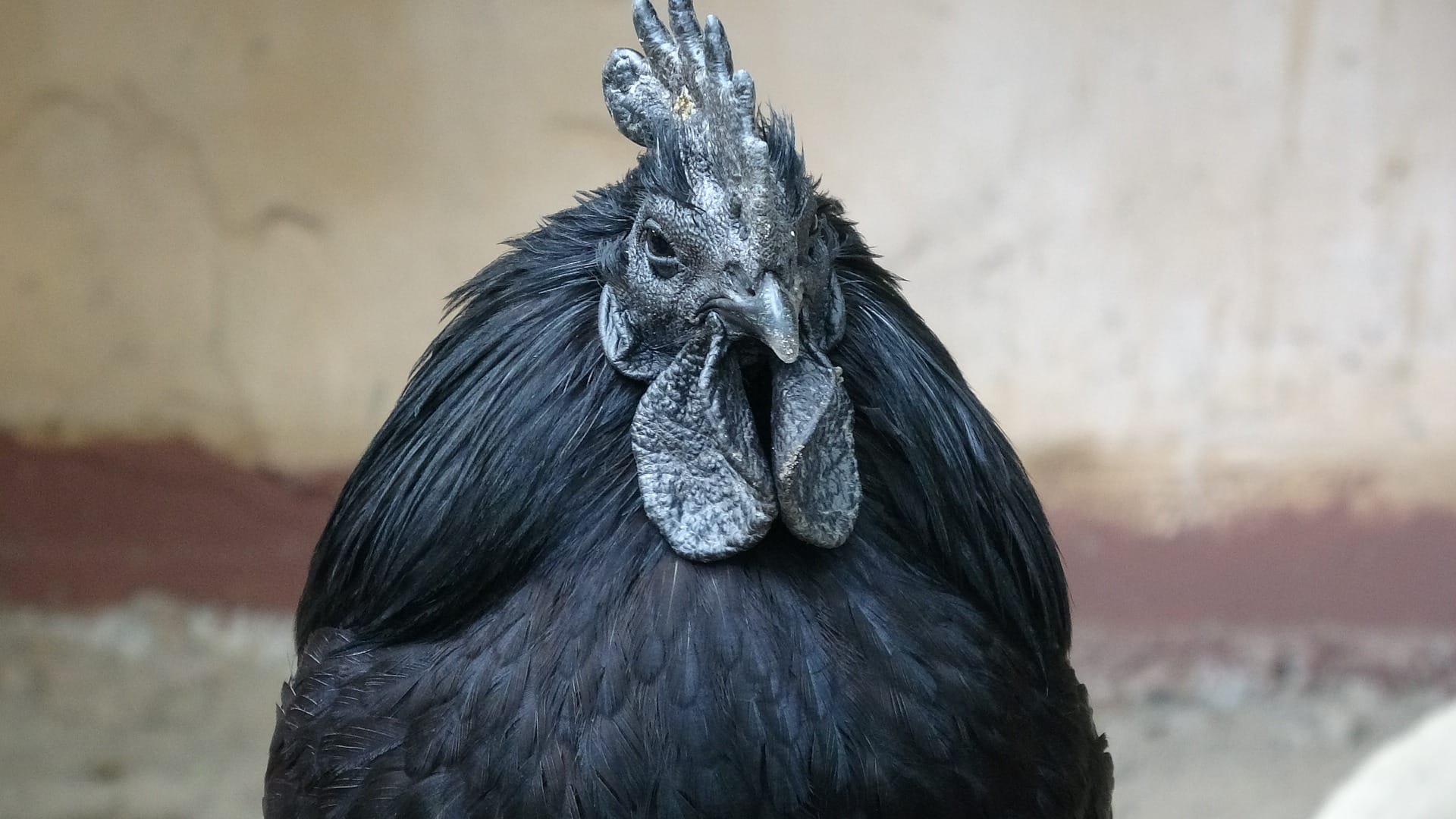Ever heard of the “Lamborghini of poultry”? That’s the Ayam Cemani chicken, famed for its striking, all-black appearance—inside and out. While the chicken often steals the spotlight, its eggs have a fascinating story of their own. This guide explores everything about Ayam Cemani eggs—from their surprising appearance and culinary uses to their availability, cost, and even how to hatch them yourself. We’ll also debunk some common myths surrounding these unique eggs. Whether you’re a seasoned poultry enthusiast or simply curious, join us as we delve into the world of Ayam Cemani eggs.
Decoding the Ayam Cemani Egg
Ayam Cemani chickens, with their captivating all-black plumage, have intrigued poultry lovers for years. Their unique appearance results from fibromelanism, a genetic quirk that causes an overproduction of melanin. But what about their eggs? Let’s crack the code and uncover the secrets of these intriguing eggs.
Appearance and Characteristics
Perhaps the most unexpected aspect of Ayam Cemani eggs is their color. Given the chicken’s intense black coloration, you might envision equally dramatic eggs. Surprisingly, Ayam Cemani eggs are a creamy, light brown, sometimes with a pinkish tint—a stark contrast to the bird itself. They’re also notably smaller than standard supermarket eggs.
Availability and Cost
Like their automotive namesake, Ayam Cemani eggs are a luxury item. Their rarity contributes to a significant price tag, often around $16 per egg. This high cost stems from the Ayam Cemani hen’s relatively low egg production—averaging about 80 eggs a year, roughly one per week, sometimes even pausing for breaks. This limited supply, coupled with high demand, keeps the price elevated. If you’re interested in purchasing Ayam Cemani eggs or chicks, sourcing from established breeders is crucial. This ensures genuine Ayam Cemani genetics and supports ethical breeding practices. Explore our guide on Appalachian cryptids for more information on rare and unusual creatures.
Nutritional Profile
While some might assume such a unique bird lays equally unique, nutrient-packed eggs, this isn’t the case. Ayam Cemani eggs offer a similar nutritional profile to standard chicken eggs, providing comparable amounts of protein and vitamins, but no extraordinary health benefits.
Culinary Uses
So, how do these prized eggs taste? Simply put, like chicken eggs. Their flavor profile aligns with regular eggs, offering versatility in any recipe. Scramble, fry, poach, bake—the possibilities are endless. However, given their cost, you might reserve them for special occasions or impressing fellow poultry aficionados. Imagine the conversation sparked by an omelet made with these unique eggs!
Incubation and Hatching
Dreaming of your own Ayam Cemani flock? You’ll need fertile eggs from a reputable breeder. Maintaining the breed’s signature black plumage requires careful selection and breeding practices. Incubation follows standard chicken egg procedures—21 days in a controlled environment with consistent temperature and humidity. It’s a delicate process, but witnessing those tiny black chicks emerge is a rewarding experience. For those fascinated by unusual life cycles, you might be interested in exploring the axolotl life span.
| Feature | Description |
|---|---|
| Origin | Indonesia (Java) |
| Appearance | Completely black (fibromelanism), except for bones and blood. |
| Temperament | Generally friendly and docile, but can be flighty, requiring a secure coop. |
| Egg Laying | Relatively low, around 80 eggs per year (about one a week) with occasional pauses. |
| Egg Color | Creamy, light brown – a surprising contrast to the jet-black hen. |
| Egg Price | Around $16 per egg – reflecting their rarity. |
| Breeding | Can be challenging; requires careful selection to maintain the black plumage; reputable breeders crucial. |
| Market Demand | High, driven by the breed’s unique appearance and the scarcity of the eggs. |
The Allure of the Ayam Cemani
The fascination with Ayam Cemani chickens extends beyond their eggs. Their striking black appearance, a result of fibromelanism, sets them apart. Their generally friendly temperament makes them relatively easy to handle. However, their tendency for flightiness requires a secure coop.
Navigating the Ayam Cemani Market
The high demand for Ayam Cemani eggs and chicks significantly influences their price. While online marketplaces offer options, sourcing from established breeders is essential for ensuring genetic authenticity and supporting ethical practices.
Ethical Breeding Practices
The allure of rare breeds like the Ayam Cemani carries a responsibility for ethical breeding—avoiding overbreeding, ensuring genetic diversity, and prioritizing the birds’ well-being. Supporting responsible breeders contributes to preserving this unique breed.
Debunking the Myth: Do Ayam Cemani Chickens Really Lay Black Eggs?
The striking appearance of the Ayam Cemani chicken often leads to the misconception that they lay black eggs. Let’s set the record straight: Ayam Cemani eggs are not black. They are a creamy beige or light brown, occasionally with a pinkish hue.
The myth likely originates from the bird’s overall appearance. With black feathers, skin, and even internal organs, it’s easy to assume the eggs would follow suit. However, fibromelanism, the genetic condition responsible for the bird’s black pigmentation, doesn’t influence eggshell color. Eggshell color is determined by different genetic factors and pigments.
While not black, Ayam Cemani eggs are uncommon due to the hens’ low egg production (around 80 eggs per year). This contributes to their mystique and higher price. Ongoing research suggests there may be undiscovered nuances to eggshell color inheritance, but for now, the black Ayam Cemani egg remains a myth.
| Trait | Ayam Cemani Chicken | Ayam Cemani Egg |
|---|---|---|
| Color | Black | Creamy Beige/Pinkish |
| Influencing Factor | Fibromelanism | Other Pigments |
Why is the Ayam Cemani So Expensive?
The Ayam Cemani’s high price tag results from a combination of factors: its unique appearance (caused by fibromelanosis), the challenges of breeding (due to the recessive fibromelanosis gene), low egg production, import restrictions, and cultural significance in Indonesia. These factors contribute to its rarity and exclusivity, making it a sought-after breed.
While an Ayam Cemani egg can cost around $16, a prize-winning breeding bird can fetch thousands of dollars, sometimes exceeding $6,000. This price reflects its rarity and the dedication required to preserve this unique breed.
What Chicken Lays All Black Eggs?
No chicken lays completely black eggs. While some chickens lay very dark eggs, a true black egg is a myth. The Ayam Cemani, despite its all-black appearance, lays creamy, light brown eggs. This myth likely stems from the bird’s overall black coloration.
The Ayam Cemani’s black coloring is due to fibromelanosis, which causes an overproduction of melanin. However, this doesn’t affect eggshell color, which is determined by separate genetic factors. Ayam Cemani eggs are smaller than average and taste like regular chicken eggs. Their rarity and the breed’s low egg production contribute to their high cost.
If you’re interested in darker eggs, consider the Black Copper Marans, known for its rich, chocolate-brown eggs. While not black, they offer a darker hue. While the Ayam Cemani, often called the “Lamborghini of poultry,” is prized for its appearance, it’s not a prolific layer. If egg production is your primary goal, other breeds are better suited.
| Feature | Ayam Cemani Egg | Standard Chicken Egg |
|---|---|---|
| Color | Cream, sometimes with a pinkish tint | Varies (white, brown, etc.) |
| Size | Smaller | Larger |
| Taste | Similar to standard eggs | Varies slightly by breed |
| Number per year | ~80 | ~250-300 |
| Cost | High ($10-$20/egg) | Low |
While current research suggests fibromelanosis doesn’t directly affect eggshell color, future discoveries in avian genetics might reveal further complexities. Perhaps someday, a truly black egg will be possible. But for now, it remains a captivating myth.
- Berea Municipal Court: A Comprehensive Guide to Ohio Traffic Violations, Misdemeanors, and Court Procedures - November 25, 2024
- Bartow County Schools Calendar 2024-2025: Key Dates and Parent Resources - November 25, 2024
- What’s Your D&D Alignment? The Ultimate Test & Guide - November 25, 2024















